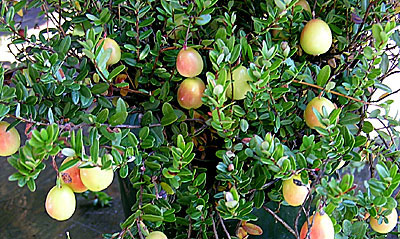 |
| Growing cranberries from seed can result in unusual fruits – such as his albino that Harker grew. English photo. |
By Jean English
John Harker thinks that our native cranberry, Vaccinium macrocarpon, is “probably one of the better crops to grow organically.” He explained its culture at the 2004 Common Ground Country Fair. When he isn’t growing or lecturing about cranberries, Harker is a business development specialist with the Maine Department of Agriculture.
Cranberries grow in low, wet, acidic areas, or in highly organic, acid soils in full sun. They won’t grow in regular garden soil, because it probably is not acidic enough and does not support the right mycorrhizae (fungi that live symbiotically with plants and help them take up nutrients). Harker suggests growing cranberries in either 100% peat moss in the garden, or in a mix of two parts peat to 1 part sand, since the mycorrhizae they need to grow are in peat moss. You can replace an 8-inch depth of sod with peat moss, then water the peat well – which may take intermittent watering for about five days, since peat moss is slow to soak up water. If you have clay under the peat moss, that’s ideal; if you have sand, Harker recommends putting a layer of plastic down, then peat moss.
Set one plant every 4 square feet or one cutting every square foot. “Throw a little extra nitrogen on the ground at first to get the runners to grow,” says Harker. “Then put 1/2 inch of sand over the plants.” Every two to three years, in late March – just after the snow melts – add a little more sand to “prune” the plants – i.e., to cover the rhizomes that have fallen over. The upright growth (not the runners) produces fruit. You can also prune off excess runners to keep the bed in a upright mode for fruiting.
 |
| John Harker demystified organic cranberry culture at the Common Ground Country Fair. English photo. |
By the fourth year, your plot should be producing fairly well. You may harvest about 1 pound per 5 square feet by the fifth to seventh year – about one-third the yield that commercial, conventional growers get. “If you grow organically, you accept some loss due to insects and disease,” said Harker.
You’ll have to weed carefully until the plants are established.
When you want to expand your planting, dig out more sod, replace it with peat moss, and let the cranberry runners grow into it. Harker likes to keep his plants within a 4′ x 8′ bed so that he can harvest berries without stepping on the plants. He harvests before the first hard frost, usually in September, and keeps the berries in a warm barn for a few weeks to continue ripening them. You can usually harvest until mid-October, since the berries don’t freeze until about 26 degrees F. To protect fruit from frost damage, you can cover plants with a blanket or plastic, or sprinkle them all night when frost threatens.
Cover the plants around Thanksgiving time with white plastic or with a few inches of leaves to prevent the winter wind from drying the leaves and killing the buds. This mulch should be removed by April 1 (or before sand is added).
Cranberries can be put right in the freezer, without blanching, after harvest. They retain a lot of their nutrition when preserved this way.
Native Americans gave cranberries to other tribes as gifts of peace and friendship, says Harker, calling it the “peace berry.”
Non-organic information about cranberry culture is available at www.umaine.edu/umext/cranberries/. Harker has growing information and sells his plants at his Web site, www.cranberrycreations.com, or contact him at 905 Sandy River Road, Mt. Vernon ME 04352; Telephone: 207-293-2356;
E-mail: [email protected]. You can also buy Maine-grown cranberry plants through Fedco Trees (PO Box 520, Waterville ME 04903-0520; www.fedcoseeds.com).When Life Gives you Fireworms, Make Cranberry Juice
by Craig Idlebrook
On an early October day, Ellsworth farmer Mike Macfarlane was still cleaning the buckets from his cranberry juice stand at the Common Ground Fair. Preparation for the Fair took months.
“Was it worth it? Yeah, I guess it was,” Mike said. It was a busy year for Pat and Mike Macfarlane (previously featured in The MOF&G in Dec. 2002), with some adventures planned, some not.
The decision to make cranberry juice for the first time came from a practical and happy problem, a bumper crop of cranberries the year before. “We said, ‘What the hell are we going to do with all these cranberries?’” Mike remembers.
Toying with a neighbor’s juicer, the Macfarlanes developed a tasty juice from organic cranberries, organic maple syrup and water. The first test of their creation came at the Full Circle Fair in Blue Hill – but the weather was rainy and few people wanted cold drinks.
The Macfarlanes then developed an accompanying hot cranberry drink. They felt the real test for their product would come at the Common Ground Fair. The process was not cheap. Mike estimates that they spent $6,000 before selling the first glass of juice at the Fair, including $1,000 on maple syrup. “It [was] a crapshoot,” he admitted.
They’re happy with the results. “You have no idea how many people said, ‘This is the best juice I’ve ever had,’” Mike said. They sold over 1,000 cups.
While they started the juice venture to deal with excess cranberries, they won’t have that problem this winter. This past growing season, they were visited by the blackheaded fireworm, a cranberry pest. Mike saw the bug early in the season but misidentified it. By the time he realized what he was dealing with, it was too late.
“By July, we were in the process of getting wiped out,” Mike said. After consulting a cranberry specialist with UMaine Cooperative Extension, the Macfarlanes decided to cut their losses. The fireworm could have been controlled easily if caught in time, but with an infestation, they had no choice but to flood the bog. For many farmers, this would have been a disaster, but the Macfarlanes are flexible and have always diversified and avoided debt. Mike said philosophically, “You can learn a lot more from a bad year than a good year.”
In many ways, the crop loss will only hasten the farm’s diversification: As competition in the organic market gets fiercer, they want to stay ahead of the curve. “Our little niches are getting invaded,” he laughed.
Their cranberry bog should recover, and the Macfarlanes want to move forward with their juice and learn about labels, shelf life and copyrights. At the next Fair, they hope to offer both juice and cranberry-flavored snowcones!
If the juice business grows, the Macfarlanes will soon be buying organic cranberries from other Maine growers. “Instead of being in competition [with the other growers], we’d like to help facilitate their development,” Mike said.
